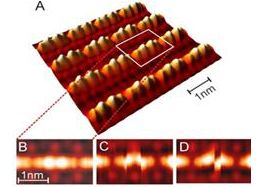Home > Press > Playing Pinball with Atoms
 |
| Scientists are reporting construction and testing of a nanotech device that responds to on-off stimuli and resembles flippers on a pinball machine. Credit: Harold J. W. Zandvliet |
Abstract:
With nanotechnology yielding a burgeoning menagerie of microscopic pumps, motors, and other machines for potential use in medicine and industry, here is one good question: How will humans turn those devices on and off? In an advance toward giving humans that control, scientists in The Netherlands are reporting use of an external electrical signal to control an atomic-scale mechanical device that looks like the flippers on a pinball machine. Their report is scheduled for the Oct. 8 issue of ACS' monthly journal Nano Letters.
Playing Pinball with Atoms
Enschede, The Netherlands | Posted on October 1st, 2008In the study, Harold J. W. Zandvliet and colleagues point out that efforts to build ever-smaller mechanical devices have made scientists recognize the difficulty of exerting control over these nanomachines, which are too tiny for any conventional on-off-switch. They describe construction and successful testing of a device, "grown" on a wafer of germanium crystal, that responds to on-off stimuli.
Researchers say the device — so tiny that billions would fit on the head of a pin — resembles the arms or flippers on a pinball machine. The signals for the arms to move back and forth come from the tip of a scanning tunneling microscope. "By precisely controlling the tip current and distance, we make two atom pairs behave like the flippers on an atomic-sized pinball machine," they state. "Our observations prove unambiguously that it is possible to control an atomic scale mechanical device using a simple electrical signal. A better understanding of similar devices can shed light on the future possibilities and opportunities for the application of atomic-scale devices." — AD
####
For more information, please click here
Contacts:
Harold J. W. Zandvliet, Ph.D.
University of Twente
MESA+ Institute for Nanotechnology.
Enschede, The Netherlands
Phone: 31(0) 53 489 3091
Fax: 31(0)53 489 1101
Copyright © American Chemical Society (ACS)
If you have a comment, please Contact us.Issuers of news releases, not 7th Wave, Inc. or Nanotechnology Now, are solely responsible for the accuracy of the content.
| Related News Press |
News and information
![]() Researchers develop molecular qubits that communicate at telecom frequencies October 3rd, 2025
Researchers develop molecular qubits that communicate at telecom frequencies October 3rd, 2025
![]() Next-generation quantum communication October 3rd, 2025
Next-generation quantum communication October 3rd, 2025
![]() "Nanoreactor" cage uses visible light for catalytic and ultra-selective cross-cycloadditions October 3rd, 2025
"Nanoreactor" cage uses visible light for catalytic and ultra-selective cross-cycloadditions October 3rd, 2025
Molecular Machines
![]() First electric nanomotor made from DNA material: Synthetic rotary motors at the nanoscale perform mechanical work July 22nd, 2022
First electric nanomotor made from DNA material: Synthetic rotary motors at the nanoscale perform mechanical work July 22nd, 2022
![]() Nanotech scientists create world's smallest origami bird March 17th, 2021
Nanotech scientists create world's smallest origami bird March 17th, 2021
![]() Giant nanomachine aids the immune system: Theoretical chemistry August 28th, 2020
Giant nanomachine aids the immune system: Theoretical chemistry August 28th, 2020
Molecular Nanotechnology
![]() Quantum pumping in molecular junctions August 16th, 2024
Quantum pumping in molecular junctions August 16th, 2024
![]() Scientists push the boundaries of manipulating light at the submicroscopic level March 3rd, 2023
Scientists push the boundaries of manipulating light at the submicroscopic level March 3rd, 2023
![]() First electric nanomotor made from DNA material: Synthetic rotary motors at the nanoscale perform mechanical work July 22nd, 2022
First electric nanomotor made from DNA material: Synthetic rotary motors at the nanoscale perform mechanical work July 22nd, 2022
Discoveries
![]() Researchers develop molecular qubits that communicate at telecom frequencies October 3rd, 2025
Researchers develop molecular qubits that communicate at telecom frequencies October 3rd, 2025
![]() Next-generation quantum communication October 3rd, 2025
Next-generation quantum communication October 3rd, 2025
![]() "Nanoreactor" cage uses visible light for catalytic and ultra-selective cross-cycloadditions October 3rd, 2025
"Nanoreactor" cage uses visible light for catalytic and ultra-selective cross-cycloadditions October 3rd, 2025
Announcements
![]() Rice membrane extracts lithium from brines with greater speed, less waste October 3rd, 2025
Rice membrane extracts lithium from brines with greater speed, less waste October 3rd, 2025
![]() Researchers develop molecular qubits that communicate at telecom frequencies October 3rd, 2025
Researchers develop molecular qubits that communicate at telecom frequencies October 3rd, 2025
![]() Next-generation quantum communication October 3rd, 2025
Next-generation quantum communication October 3rd, 2025
![]() "Nanoreactor" cage uses visible light for catalytic and ultra-selective cross-cycloadditions October 3rd, 2025
"Nanoreactor" cage uses visible light for catalytic and ultra-selective cross-cycloadditions October 3rd, 2025
|
|
||
|
|
||
| The latest news from around the world, FREE | ||
|
|
||
|
|
||
| Premium Products | ||
|
|
||
|
Only the news you want to read!
Learn More |
||
|
|
||
|
Full-service, expert consulting
Learn More |
||
|
|
||








